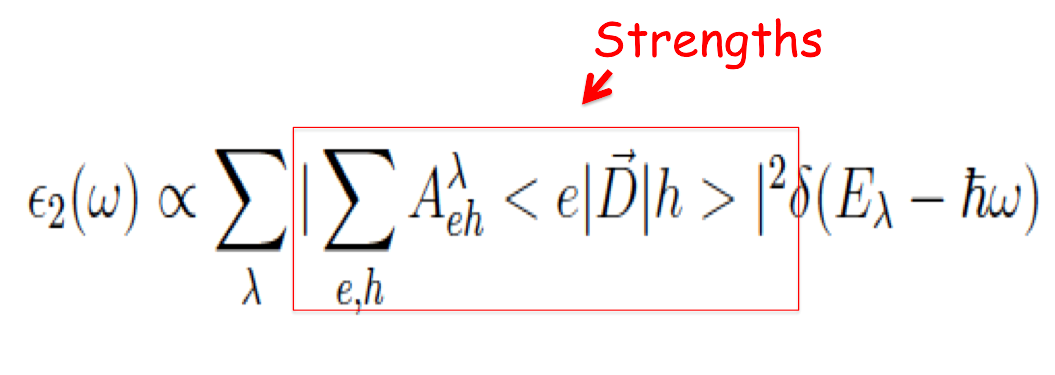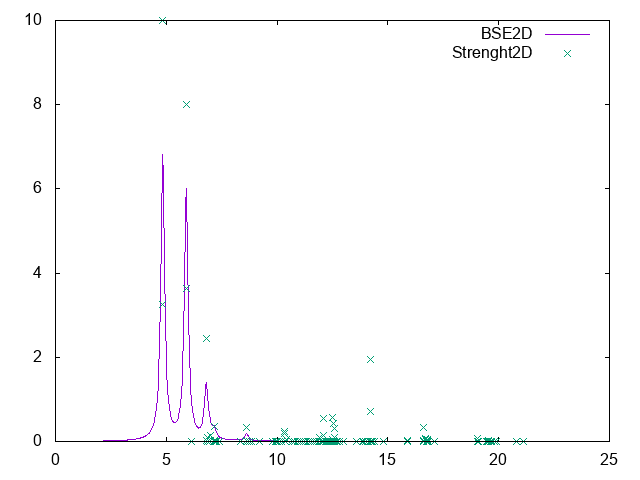How to analyse excitons: Difference between revisions
No edit summary |
|||
| Line 18: | Line 18: | ||
$ ls ./SAVE | $ ls ./SAVE | ||
ndb.gops | ndb.gops ndb.kindx ns.db1 ns.kb_pp_pwscf_fragment_1.... | ||
ns.kb_pp_pwscf_fragment_1 | |||
==Sorting the excitonic eigenvalues== | ==Sorting the excitonic eigenvalues== | ||
Revision as of 14:25, 30 March 2017
In this tutorial you will learn (for a 2D-hBN) how to:
- How to analyze a BSE optical spectrum in terms of excitonic eigenvectors and eigenvalues
- How to plot the excitonic wavefunction
Prerequisites
Previous modules
- You must have completed the tutorial on 2D hBN.
- You must have completed the tutorial on 2D hBN.
You will need:
yppexecutablexcrysdenexecutablegnuplot or xmgraceexecutable
YAMBO calculations
If you have completed the tutorials of 2D hBN you should have all the databases required to do this tutorial in your SAVE and 2D directories
$ ls ./SAVE ndb.gops ndb.kindx ns.db1 ns.kb_pp_pwscf_fragment_1....
Sorting the excitonic eigenvalues
$ ypp -e -s -J 2D
The new generated file o-2D.exc_E_sorted (o-2D.exc_E_sorted) reports the energies of the excitons and their Dipole Oscillator Strenghts sorted by energy (Index).
Open the first file and look inside. The first exciton is at 4.83 eV and the second one has the highest strenght (normalized to 1) Attention: clearly the convergence of these results has to be checked doing several BSE calculations with different k-grids!
Or you can make a plot
$ gnuplot gnuplot> plot 'o-2D.eps_q1_diago_bse' w l title 'BSE2D' ,'o-2D.exc_E_sorted' u 1:($2*10) title 'Strenght2D'
Analyze the excitons
We can now analyze the excitons in terms of single-particle states to do that create the appropriate input
$ ypp -e a -F ypp.AMPL.in -J 2D
To analyze the first 5 excitons change this line as:
States= "1 - 5" # Index of the BS state(s)
Close the input and run ypp
$ ypp -J 2D -F ypp_AMPL.in
$ls ls o*exc*at* o-2D.exc_amplitude_at_1 o-2D.exc_amplitude_at_3 o-2D.exc_amplitude_at_5 o-2D.exc_weights_at_2 o-2D.exc_weights_at_4 o-2D.exc_amplitude_at_2 o-2D.exc_amplitude_at_4 o-2D.exc_weights_at_1 o-2D.exc_weights_at_3 o-2D.exc_weights_at_5
Open the files for the first exciton o-2D.exc_weights_at_1 reports the Weights, while o-2D.exc_weights_at_1 the amplitudes
where given
the exciton ![]() in terms of e,h states,
the weights are
in terms of e,h states,
the weights are ![]() while the amplitudes are defined as
while the amplitudes are defined as 
weights [math]\displaystyle{ |\Lambda_{eh}^\lambda|^2 }[/math] where


